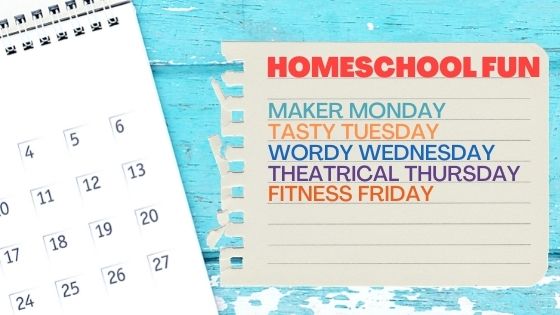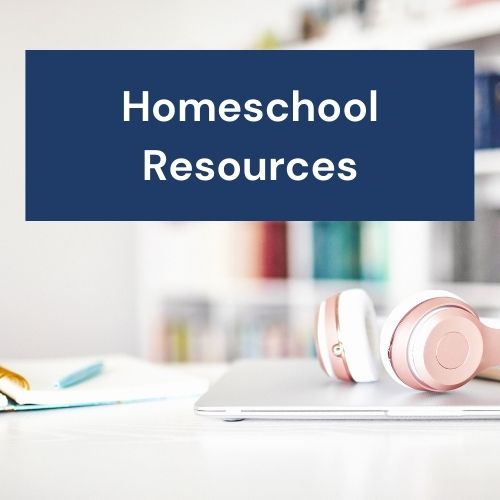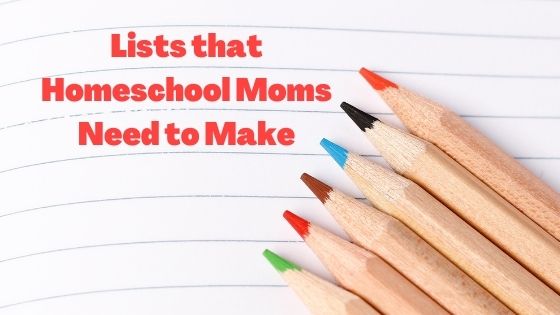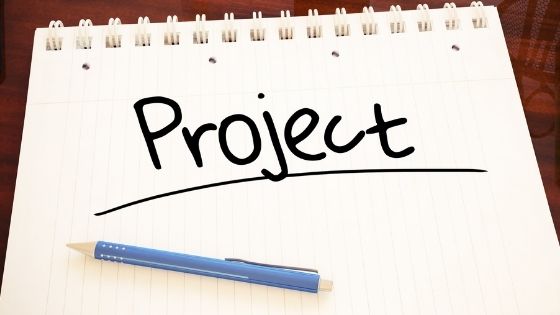Homeschool Fun with Daily Themes
Looking for a way to change up your regular homeschool week? Try incorporating theme days in your homeschool for a break from your usual routine. This article will give you five ways to plan a homeschool day with theme ideas to keep learning fun. Do a whole day focused on a theme, substitute an activity or two, or plan a whole week of fun, themed activities. You can also use themed days to create a DIY summer camp for your kids. These boredom-busters are even more fun when you use a daily theme to keep it interesting!
If you’ve ever sent your kids to a summer camp or VBS, you know they often use daily themes to direct activities. Everyone loves a theme, and you can dive into a broad range of activities within each theme. You’ll find activity ideas here for each of the following themes: Maker Monday, Tasty Tuesday, Wordy Wednesday, Theatrical Thursday, and Fitness Friday. Below you’ll find quick links to make it easy for you to find the specific suggestions and sample lesson plans for each day.
Maker Monday
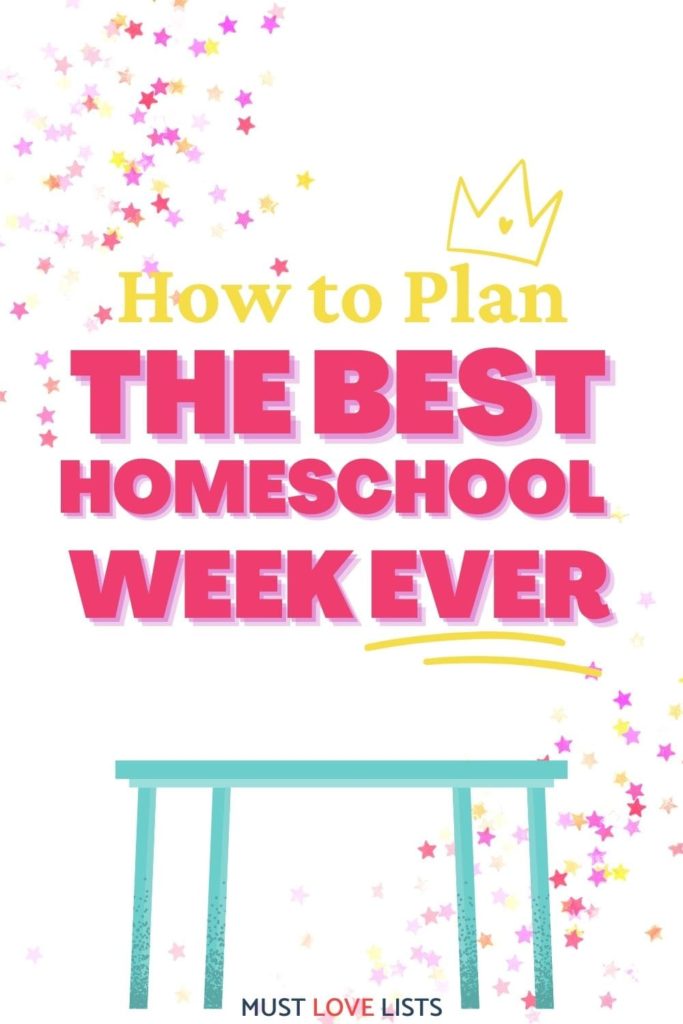
Here are some additional theme ideas you could use for each day:
MONDAY
- Marvelous Monday
- Masterclass Monday
- Motivation Monday
- Movement Monday
- Music Monday
TUESDAY
- Tech Tuesday
- Top Ten Tuesday
- Transformation Tuesday
- Trivia Tuesday
- Try It Tuesday
WEDNESDAY
- Wacky Wednesday
- Wellness Wednesday
- Words of Wisdom Wednesday
- Workout Wednesday
- Writer’s Workshop Wednesday
THURSDAY
- Thankful Thursday
- Thoughtful Thursday
- Throwback Thursday
- Thrifty Thursday
- Thrilling Thursday
FRIDAY
- Fabulous Friday
- Fact Attack Friday
- Foodie Friday
- Fun & Games Friday
- Future Focus Friday
(Disclosure: As an Amazon Associate I earn from qualifying purchases. This means that if you click a link and make a purchase, I may receive a small commission at no additional cost to you. I only recommend products I use and love or would love to use! For full disclosure details, click here.)
Get the whole printable bundle with activities, resources, and lesson plans from my Etsy shop!
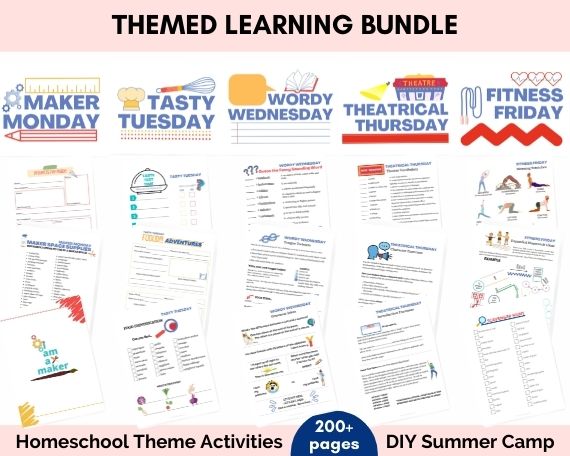

MAKER MONDAY IDEAS
To begin, let’s start the week with a Maker Monday theme. Maker spaces have been very popular in recent years, and you can encourage your kids’ natural creativity by providing them with opportunity for hands-on learning activities. Focus on making and creating with STEM activities, arts & crafts, puzzles, and more.
LEGO CHALLENGES
Grab a stopwatch (use your phone) and have your kids pull out their LEGO bins for this one. Depending on their interest and aptitude levels, give them timed challenges ranging from simple builds like a “tree” or “hat” to much more elaborate and time-consuming challenges for kids who are really into LEGO.
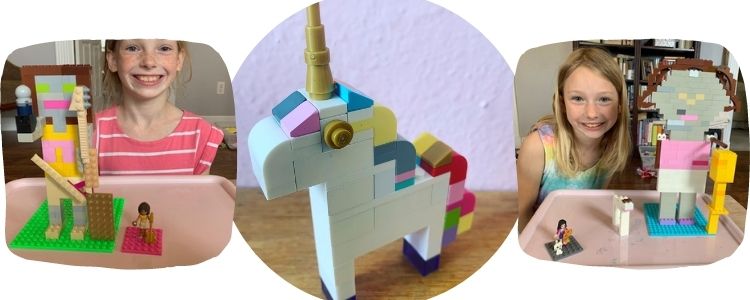
SIMPLE LEGO CHALLENGES
Allow 2-10 minutes for each of these simple LEGO builds.
- car
- dog house
- animal (cat, spider, bunny, panda, etc.)
- tower
- bridge
- desk
- bookshelf
- flower
- pyramid
- irregular shape
- bucket
- umbrella
- cup
- robot
ADD-ON CHALLENGES WITH TIME LIMITS
Give your kids 30-60 minutes to build as much of a town, jungle, or skyscraper as possible. Add to this weekly, or let it be a jumping off point for a free-time activity later. Here are some ideas of more involved things they can create:
- town
- school
- space station
- jungle
- amusement park
- beach
- castle
- skyscraper
- farm
- dream house
ADVANCED LEGO MASTER CHALLENGES
If your kids are really into LEGO, give them a LEGO Masters type challenge that will keep them busy all day! Here are a few suggestions:
- dragon or dinosaur
- favorite scene from a book or movie
- maze
- scene that incorporates words
- treehouse village
- bakery with detailed baked goods
ARTS & CRAFTS
Offer a variety of crafting activities to introduce something new, or allow your kids to work on a craft activity they enjoy. Here is a sample of arts and crafts activities your kids might like:
- make a bracelet or necklace: use yarn, beads, loom bands, even paper clips
- perler beads
- string art
- crochet
- embroidery
- clay or playdough modeling
- origami
- watercolor painting
- creative lettering
- paper flowers
- Spirograph
- go outside and sketch a tree, flower, bicycle, or your house
- roll of paper: wrap your dining room table, line a hallway or the side of your garage and offer markers, colored pencils or paint for them to use. On a table, have them design a tablecloth with repeating patterns or abstract art. On a wall, they can create a mural (theme ideas: superheroes, cityscape, field of flowers, graphic lettering)
- gather boxes big and small and let your kids create a town, spaceship, school, or anything else they want
- design a room, a house, or other to-scale space on graph paper
Read 99 Fun Paper Activities for Kids
Items You May Use for Maker Monday Arts & Crafts
MAKER SPACE
Provide a variety of household supplies and tools for your kids to use in any way they want. You can get very high-tech with this; these suggestions are a simple, hands-on supply list suitable for almost any age.
HOUSEHOLD ITEMS TO INCLUDE IN A MAKER SPACE AREA
- toothpicks
- cotton balls
- cut-up dish sponges
- packing material
- buttons
- nuts and bolts
- washers
- hinges
- dowels
- wine corks
- foam
- cardboard
- popsicle sticks
- drinking straws
- paper plates & cups
- pipe cleaners
- yarn
- duct tape
- twine
- scissors
- tape
- hole punches
- thread
- white glue
- glue sticks
- wood glue
- Gorilla glue
- clamps
- screwdrivers
- paper towel/toilet paper tubes
- pompoms
- rubber bands
- paper clips
- wood blocks
- balloons
- coffee filters
- plastic bottles
- fabric
- ribbon
- magnets
- bamboo skewers
- Q-tips
- binder clips
- PVC pipe
- clothespins
- perler beads
- Playdough
- glue dots
- Mod Podge
- foam brushes
- self-adhesive velcro
- zip ties
- sandpaper
- construction paper
- wrenches
- needle and thread (for older kids)
- glue gun (for older kids)
Items You May Use for Maker Monday Maker Space
PUZZLES
Puzzles are a great way to have fun while building critical thinking skills. Here are just a few suggestions you can add to a puzzle time for Maker Monday.
- jigsaw puzzles
- mechanical puzzles
- Rubik’s cube
- logic puzzles
- brain teasers
- maze puzzles
- tangram puzzles
Fun Puzzles for Maker Monday
MORE MAKER MONDAY IDEAS
There are so many ways your kids can make and create. Offer some of these options as an activity to fill out the day during a choose your own adventure time.
- build a fort
- snap circuits
- gears
- magnetic blocks
- wooden blocks
- snowflake blocks
- K’nex
- erector set model kits
HOMESCHOOL MAKER MONDAY THEME DAY
9:00 AM: LEGO CHALLENGES
10:00 AM: BUILD-A-STACK SNACK TIME (Provide crackers, cheese, salami, pickle slices, cucumber slices, tomato slices—anything that can stack!
10:15 AM: MAKER SPACE
12:00 PM: LUNCH/OUTDOOR PLAY
12:30 PM: PUZZLE TIME
1:00 PM: CHOOSE YOUR OWN ADVENTURE/CHOICE TIME
2:00 PM: DONE FOR THE DAY (I bet they won’t want to stop!)

TASTY TUESDAY IDEAS
On Tuesday, focus on food, with an emphasis on health. Not only will they have fun, your kids will learn valuable life skills. For example, reading recipes can be reading, math, and science all in one lesson. Have them double a recipe and convert the measurements. Then, talk about the chemistry behind baking soda or baking powder in a cookie or muffin recipe.
Here are some suggestions for Tasty Tuesday activities:
START A RECIPE BINDER
Give your kids a small three-ring binder to start their own collection of favorite recipes. They can begin by making a list of their favorite meals, favorite breakfasts or favorite dinners to put in the front of their binder. You may suggest a pancake recipe, muffin recipe, and cookie recipe to start. They may also like to add recipes for simple dinners like spaghetti, tacos, or baked potatoes with ham and broccoli. Kids often enjoy making smoothies, and these can be a great healthy snack or breakfast!
FOOD IDENTIFICATION
Visit the product section of your local grocery store and see how many foods your kids can identify. You could do this in your own home, but going to the store adds a field trip element of fun, and allows your kids to explore a much greater variety of foods than you would typically stock in a home kitchen.
TRY A NEW FOOD
While you’re at the grocery store, let your kids choose a food they’ve never tried before and bring it home to try. This works especially well with fruits or vegetables that don’t require any cooking, but you could allow them to pick other things and cook them for dinner also.
Get my Eat the Alphabet Healthy Food Challenge
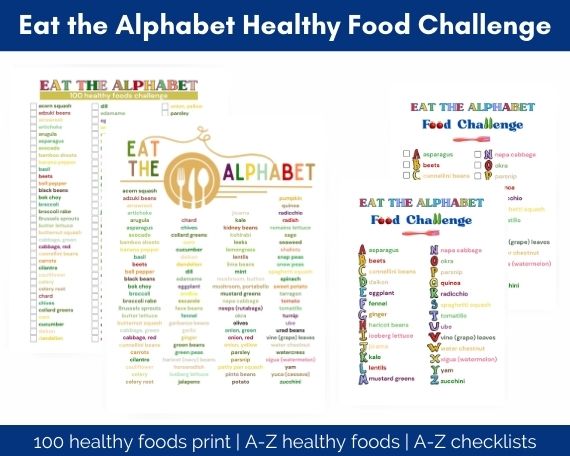
WHOLE FOODS VS. PROCESSED FOODS
Talk about whole foods vs. processed foods. Explain to your kids the way grocery stores are set up to hold whole foods mostly around the perimeter of the store, with the interior aisles containing mostly processed foods. An easy way to explain “whole foods” to kids is to tell them that whole foods are recognizable as something they would see in nature—a potato, leaf of lettuce, or fish. Whole foods include fruits, vegetables, legumes, nuts, seeds, whole grains, meat, fish, and eggs.
Processed foods can range from minimally processed to heavily processed. Generally speaking, the more processed the food is, the less healthy it is for your body. Processing is changing, refining or adding ingredients to food.
Place a variety of whole and processed foods on a table and have your kids sort them into piles.
NUTRITION LABELS
Help your kids learn to read nutrition labels. Look at the ingredient list to see whether there are a lot of hard-to-pronounce words. Ingredients are listed in order of quantity. The first ingredient is what mostly makes up the food, followed by the second ingredient, the third, and so on. Seeing sugar listed near the beginning of the ingredient list is a clue that this food is probably not very good for you.
Have your kids pay attention to serving sizes on snack foods. A nutrition label on one box of crackers might say that they are 75 calories, while another box says 90 calories. It is important to look at the serving size and consider how much you normally eat in a serving to know how to compare one to the other.
MEAL PLAN
Have your kids come up with a meal plan for a week. They can look through cookbooks or magazines, browse Pinterest, or think about their favorite meals. See if they can think about how to cook something on one day and repurpose it for a second dinner. For instance, cooking ground beef for tacos on Tuesday, and then making a taco salad for Wednesday. Or chicken breasts left over from Thursday could be used to make a wrap or sandwich for Friday.
TASTE TEST
Blindfolded or not, a taste test can be a fun way to try to identify differences in taste. Slice several different kinds of cheese, apples, or peppers and see if your kids can differentiate between the tastes and choose a favorite. You can blindfold them and see how many different fruits and vegetables they can identify without their eyes!
Another possibility is to have them try different types of taste: sweet, sour, salty, spicy, bitter
America’s Test Kitchen has a printable cheese taste test activity to try, along with other kid-friendly recipes and activities.
100 days of real food has a printable worksheet you can use to record tastes and guesses for specific foods.
Create.Play.Travel has a great tutorial on creating a lunchtime taste test.
MAKE DRY MIXES
This is a great way to have your kids practice reading recipes and measuring properly while doubling, tripling, or quadrupling a recipe. Choose some of your favorite recipes for baked goods—pancakes, waffles, muffins, cake, cookies, or quick breads. Your kids can prep dry mixes ready to measure and add wet ingredients to whenever you’re ready to make a batch.
Read Favorite Make-Ahead Mixes
BAKE SOMETHING
Pick a recipe to complete from start to finish. Bake a cake, make bread, or even simple no-bake cookies. Depending on the age and ability of your kids, have them help with specific tasks, or let them choose and recipe and take responsibility for making it with limited involvement on your part.
TABLE SETTING
Practice setting a dinner table. Give your kids instruction in where to place the forks, knives, spoons, and glasses. Have them learn a fun way to fold a napkin. Talk about courses and what they might expect from a three-course, four-course, or five-course meal. A course is essentially a part of the meal that is served separately. So a three-course meal would have an appetizer, main course, and dessert. A four-course meal would add an hors d’oeuvre course before the appetizer, and a five-course meal would typically have an hors d’oeuvre, appetizer, salad, main course, and dessert.
FANCY DINNER
If your kids love working in the kitchen, give them the opportunity to help you make a full dinner. My kids love our occasional Fancy Friday dinners, but there’s no reason you couldn’t have a fancy dinner on Tasty Tuesday.
Here’s a possible menu for a three-course fancy dinner:
Appetizer: Cucumber slices topped with cream cheese and piece of cherry tomato
Main Course: Salmon w/rice and roasted veggies
Dessert: Fruit & yogurt parfaits
Items You May Use for Tasty Tuesday
HOMESCHOOL TASTY TUESDAY THEME DAY
8AM: BREAKFAST
Learn to scramble and fry eggs (eat and clean up)
8:30AM: RECIPES
Start a recipe binder or notebook to keep favorite recipes
Begin a list of favorite meals
9:00AM: FOOD IDENTIFICATION
Visit the produce section of a grocery store: choose several new foods to purchase
10:00AM: NEW FOOD ADVENTURE
New food adventure: talk about how it looks and tastes, where it grows, whole foods vs. processed foods
10:30AM: NUTRITION LABELS
Learn to read labels: look at ingredient lists, calories, fat, sugar, serving sizes
11:00AM: CREATE A MEAL PLAN
Write out a dinner meal plan for one week
12:00PM: LUNCHTIME TASTE TEST
Hold a blind taste test: taste different cheeses or apple varieties, see how many fruits and vegetables you can identify while blindfolded
1:00PM: PREPPING DRY INGREDIENTS FOR BAKING
Make dry mixes for pancakes, muffins, or cookies
1:30PM: TABLE SETTING
Practice setting the table for dinner/set up for fancy dinner!
2:00PM: DONE FOR THE DAY!
OPTIONAL: Help prep, cook, and plate a “fancy dinner”

WORDY WEDNESDAY IDEAS
On Wednesday, the focus will be fun with words. You can spend the day reading and writing if your kids already love to do those things. If your kids are a little more reluctant to spend an entire day doing what feels like “regular school,” here are some ideas to add a little excitement to Wordy Wednesday.
- read books out loud
- listen to an audiobook
- turn on a podcast while they work on a word search
- choose inspirational quotes for personal motivation
- read or listen to famous speeches
- say funny-sounding words out loud
- grammar jokes or puns
- learn a new word
- Mad Libs
- create a comic book
- add captions to pictures
- journaling with prompts
- create an acronym with the letters of your name
- small talk
- tongue twisters
- word games: Scrabble, Boggle, Scattergories
- write a song
- READ!
READ ALOUDS
Choose a funny book to read out loud to your kids. A few suggestions:
- The Book with No Pictures
- Goldilocks and the Three Dinosaurs
- I Want My Hat Back
- Wordy Birdy
For older kids, read a chapter of a book you think they might like. A little teaser might be just what they need to pick it up to read on their own. Find suggestions for every age and interest at Read-Aloud Revival.
Have your kids read aloud to each other, either a favorite children’s book, or a passage from their favorite chapter book.
Books You May Want to Use for Wordy Wednesday
AUDIOBOOKS
Introduce a new book by listening to a chapter of an audiobook, or listen to a shorter book in its entirety. Try your library app, such as Libby or Overdrive, Audible, or a website for kids such as StoryTime Online (listening only if you want to keep it screen-free).
Another option is Lit2Go. Here, you can sort by grade level, author, or title, and many of the books offer a PDF download you can print to have your child follow along. These are a few of my suggestion for using the printed passage as your child reads along with the audio. Choose something that reinforces learning they have already been doing this year.
- circle all the adjectives
- underline the prepositions or prepositional phrases
- highlight dialogue
- mark similes with an S or metaphors with an M
- circle the action words
- highlight adjectives that describe the protagonist
PODCASTS
There are so many great podcasts for kids these days. Here are some suggestions for podcasts to listen to on Wordy Wednesday.
- The Good Words Podcast: introduce funny, fascinating, and all-around interesting word concepts with this fantastic podcast
- Word Matters Ep.12: A Collection of Obscure Words for People Who Annoy You: Best for older kids, young ones will not be able to follow the conversation (~ 9 minutes)
- But Why: A Podcast for Curious Kids: Who Invented Words? (~ 15 minutes)
- Brains On!: Books: How They’re Made and How Your Brain Reads Them (~ 30 minutes)
INSPIRING WORDS
Have your kids choose a famous quote that motivates them, and make a poster to display at their desk or in their room. They could even make up their own quote.
Read Monthly Motivation for Kids for inspirational quote ideas
FAMOUS WORDS
Read or listen to a famous speech or piece of literature. Talk about how some words become inextricably entwined with a specific person or event.
- Martin Luther King, Jr.’s “I Have a Dream” speech
- Michelle Obama commencement speech
- JFK famous inaugural passage
- Abraham Lincoln Gettysburg speech (read by Jeff Daniels)
See if your kids can identify the source or context of some famous words:
- We the people… (U.S. Constitution)
- Ask not what your country can do for you… (John F. Kennedy)
- One small step for man, one giant leap for mankind. (Neil Armstrong, stepping on the moon)
- I came, I saw, I conquered. (Julius Caesar)
- We’re not in Kansas anymore. (Dorothy in The Wizard of Oz)
- In the beginning, God created the heavens and the earth. (First verse in the Bible)
- We are gathered here today… (beginning of wedding ceremony)
- I have a dream… (Martin Luther King, Jr.)
- Break a leg! (good luck to someone who is appearing in front of an audience)
- Just keep swimming (Finding Nemo)
- To be or not to be… (William Shakespeare, Hamlet)
- Long, long ago in a galaxy far, far away (opening line of Star Wars)
FUNNY WORDS
Have your kids read some funny-sounding words and guess their meanings. Find some funny words to use at Express Writers. Make this an active game for even more fun.
- Write the funny or obscure words on index cards (one word per card).
- On separate index cards write the definitions to each word (one definition per card).
- Place the words and definitions at opposite ends of the room or your backyard.
- Have your kids start in the middle and run to grab a word.
- They should run back to place the word next to the card that they believe has the correct definition.
- Repeat until all words are matched with definitions.
- Check their answers and let them know which ones they matched incorrectly.
- They can work together to try to determine the correct definitions (give hints if needed).
PERSONAL WORDS
Print a list of words, like this character trait list from Teaching Made Practical. Then, have your kids choose words to describe themselves. They could create a poster for their wall, using different fonts and sizes for each word. Or, use the free word search builder at education.com to make a word search using their descriptive words. Circle the words and display the completed word search in a frame or on a bulletin board.
DICTIONARY GAME
If you have multiple kids, choose a list of words and give each child a dictionary (yes, a paper dictionary, not the internet!). Call out a word and have them race to find the word and read the definition. If your kids are frustrated by an older one always getting there first, take turns and give them their words separately. Another way to do this would be to have your kids take turns choosing the words. So once the first child finds the word and reads the definition, they get to quickly scan their dictionary for a word to call out to the next one.
If your kids like the competitiveness of racing to find the word, but they are not evenly matched, you can use a stopwatch to have them compete against themselves for the quickest time to find their words.
Make it active by having your kids jump up when they find the word!
SMALL TALK
Have your kids think about the use of words in conversation. What are some questions they could politely ask when they first meet someone? Brainstorm some questions they could ask to get to know a neighbor, new kid in the class, or teammate.
- What do you like to do on the weekend?
- Do you take any lessons or classes for fun?
- Do you like to read? What was the last book you read? What did you like about it?
- Have you seen any good movies lately?
- What’s your favorite food?
MAD LIBS
Mad Libs are a fun way for kids to be entertained by word usage. Find printable mad libs at Read Brightly, Woo!Jr, or Mad Libs.
GRAMMAR JOKES
A quick internet search will turn up plenty of grammar jokes. You can also read Eats, Shoots, and Leaves by Lynne Truss for hilarious examples of how commas really do make a difference.
Items You May Use on Wordy Wednesday
MAKE YOUR OWN COMIC BOOK
For kids that love to draw, but aren’t so keen on writing, try having them create a comic book. Picklebums.com has some free comic book templates you can download and print. Your kids can then design their own graphics and add words to the callouts.
CREATIVE CAPTIONS
You actually can do a fun caption activity without screens. Grab some magazines or picture books to get a variety of pictures. It works great to pull pages out of magazines and post them on a bulletin board or magnetic board. Picture books can be opened and laid out on a table. Use a post-it note to assign each image a number.
Then, have your kids number a paper with however many images you have, leaving a few lines of space in between each number.
They can browse the images throughout the day, or be given a time frame, like 15 minutes, to come up with funny captions.
NAME ACRONYM
Have your kids write out their names, with letters going down the page. Then ask them to brainstorm adjectives to describe themselves or things they love beginning with each letter of their name. Your little artists can have a fun time creating a decorative poster out of this.
JOURNALING
Have your kids choose a journal prompt for a 5-minute journaling session. Some journal prompt suggestions for this are below. Set a timer for 5 minutes and have them write independently. They can choose to share their writing with you or not.
- What would you do with $1000 dollars?
- If you could travel to anywhere you’ve read about in a book, where would it be and what would you see?
- What do you think is the most important quality in a friend?
- Describe in detail what you think your life will be like in five years. Some ideas to think about: What time will you wake up, what activities will you be doing, do you have a job, what classes will you take, what will you eat for breakfast, where will you want to spend your time?
- What do you love about life?
Read 365 Fun Journal Prompts for Kids
TONGUE TWISTERS
Tongue twisters are a fun way to play with words. You can find plenty of printable tongue twisters at Teachers Pay Teachers. Have your kids practice saying them, and even writing their own!
You could also read a tongue twisting book like “Oh Say Can You Say?” by Dr. Seuss
WORD GAMES
Play a classic word game to expand vocabulary, work on spelling, and think creatively. Scrabble, Boggle, and Scattergories are a few of our favorites, as well as Taboo, Catch Phrase, and Mad Gab. A few others that would be good options are Bananagrams, Upwords, or Play on Words.
My kids started playing Boggle well before they were readers. It’s easy to play with multiple age ranges by adjusting the rules to fit the players. Pre-readers get points for any letters they can identify. The next step is to allow points for single-letter words, 2-letter words, 3-letter words and up.
As an example, the youngest kids receive points for any single letter words and everything higher. Five to nine-year-olds may receive points for 2-letter words and higher. Ten to thirteen-year-olds may be required to have at least 3 letters to qualify for a point. And older teens or parents only receive points for words at least 4 letters.
Games You May Use on Wordy Wednesday
HOMESCHOOL WORDY WEDNESDAY THEME DAY
9:00 AM: PODCAST
Word Matters Ep.12: A Collection of Obscure Words for People Who Annoy You
Word search
9:15 AM: DICTIONARY GAME
9:30 AM: SHORT READ ALOUD
9:45 AM: TONGUE TWISTERS
10:00 AM: JOURNALING & SNACK
10:15 AM: FUNNY WORDS GAME
10:45 AM: GRAMMAR JOKES
11:00 AM: FAMOUS WORDS
11:30 AM: READ ALOUD
12:00 PM: LUNCH/OUTDOOR PLAY
12:30 PM: CHOICE TIME
1:30 PM: PODCAST + CHOICE TIME ACTIVITY
Brains On!: Books: How They’re Made and How Your Brain Reads Them
2:00 PM: DONE FOR THE DAY!

THEATRICAL THURSDAY
Bring the drama with Theatrical Thursday. You’ll encourage your kids to memorize, create costumes and sets, write, and more with these activities.
- Warm-ups
- Charades
- Character exercises
- Monologues
- Costume creation
- Improvisation
- Writing dialogue
WARM-UPS
Try the introductions and applause exercise from Beat by Beat Press. Each child enters the “stage,” introduces themselves (Hi, my name is…) and shares one interesting piece of information about themselves. Everyone applauds, and then they exit the stage.
Dance Your Name from Beat by Beat Press. Students use body parts to spell each letter of their name. For example: 1st letter = head, 2nd letter = arm, 3rd letter = hips, 4th letter = knee, 5th letter = foot. Any additional letter simply start again at the head and move through the sequence.
CHARADES
Use a word list to play charades. One child chooses a word and attempts to get everyone else to guess the word. You can find a printable list of words for charades from Bonbon Break.
Feel free to adapt this game to suit your kids. Typically, charades is played in teams, but you can have your kids try to guess at every turn. Set a timer for a designated time and see how many they can get before the timer runs out. Allow the kids to take turns rather than the person guessing correctly to always be the actor.
CHARACTER EXERCISES
Have your kids get into character. You can use the creative exercises with character cards from Broadway Teaching Group. If you choose to do this, you’ll have to prep in advance to prepare character cards for your kids to choose from. You can then go as deeply into the lesson plan as you wish. Your kids will name and describe their character. They can then use those characters to come up with a solution to a problem or write a monologue for their character based on a given scenario.
MONOLOGUES
Use one of the free monologues from Beat by Beat Press, and have your kids work on memorization.
Allow your kids to read a monologue from a favorite book. You could also let them perform a monologue from a favorite movie. Here is another source for monologues from Disney movies. And one final source for monologues suitable for kids from Daily Actor.
Alternatively, have your kids write their own monologue to perform.
COSTUME CREATION
Have your kids put together a costume for a specific character using clothing or materials you have. They should explain why the character has that clothing, hairstyle, accessories, etc.
Try the garbage bag costume activity from Broadway Teaching Group. Give your kids a box of cheap garbage bags and have them each create a costume using only the bags.
How Costume Displays Character
If you have a basic artistic ability, use a whiteboard to draw a picture of a woman in a plain dress. Ask your kids to describe the character to you. Then, change something about the picture:
- Add a bustle to the dress and a bun to the hair
- Change the color
- Adjust the fit to be more body-conscious or looser
- Change the length
- Add accessories
- Change the hairstyle
- Add pattern
Each time you change the picture, ask your kids to describe what they think about the character. They can probably start to identify older/younger, rich/poor, from another time in history, futuristic—and see how costume informs character.
IMPROVISATION
One Word at a Time
Have your kids take turns adding to a story one word at a time. Set a timer for 5 minutes and see how much they can create.
Prop Game
Provide a selection of household items for your kids to use as props. They must take turns selecting a prop and come up with a brief scene in which they use the prop as something other than its intended use. Everyone else guesses what the item is being used as.
WRITING DIALOGUE
For a beginner activity, have your kids write a scene from a picture book in a screenplay format. You can use a playwriting template, like this one from Teach 123, or simply give your kids simple instruction about how to format a screenplay using stage directions in parenthesis and dialogue identified by the character speaking.
As a more advanced activity, your kids can try their hand at writing a scene of a play.
Mensa for Kids has an excellent tutorial walking through the basics of how to write a screenplay.
You can also find a substantive guide to teaching kids how to write a play from learningtogive.org.
Items You May Use on Theatrical Thursday
BUILDING SETS AND BACKDROPS
Have your kids create a set/backdrops for the scene they are writing. Use a roll of paper to cover a wall, a sheet of plywood, sheets or shower curtains.
CREATE AN ADVERTISEMENT
Your kids can make a poster advertising their play. Have them be sure to include the name of the play and artwork that gives some kind of clue as to what the play might be about.
PERFORM A SCENE
Have your kids rehearse a scene using a script. They can use a ready-made script for kids, like the ones at A to Z Homeschooling, or their own if they’ve been writing their own scene. My three girls loved doing a scene from Little Women and took turns playing each character.
HOMESCHOOL THEATRICAL THURSDAY THEME DAY
9:00 AM: INTRODUCTION EXERCISES
9:15 AM: CHARADES
9:45 AM: MONOLOGUES
10:30 AM: SNACK/BREAK
10:45 AM: COSTUME CREATION
11:30 AM: PROP GAME
12:00 PM: LUNCH/OUTDOOR PLAY
12:30 PM: PERFORM A SCENE
1:30 PM: KIDS’ CHOICE
2:00 PM: DONE FOR THE DAY!

FITNESS FRIDAY IDEAS
Incorporate movement and nutrition into a fun day of school with Fitness Friday. Plan a whole day of fitness activities, like a field day, or add a fitness element to regular schoolwork with games that require movement. Try some of these ideas for active learning and fun.
- morning stretches
- yoga
- go for a walk
- play Just Dance or Wii games
- hopscotch
- obstacle course
- Family Olympics
- make a healthy snack list
- math facts finder game
- create-a-quote sticker game with movement
- throw-a-state capitals game
- jump rope spelling bee
- catch the adjective alphabet game
- scavenger hunt
MORNING STRETCHES
Start your morning off with a few stretches to get warmed up.
- Side bends (30 seconds each side)
- Downward dog (30 seconds)
- Cobra (30 seconds)
- Crescent lunge (30 seconds each side)
- Child’s pose (30 seconds)
- Cow (30 seconds)
- Pigeon (30 seconds each side)
- Tree pose (30 seconds each leg)
- Sumo squat (30 seconds)
- Puppy pose (30 seconds)
Read 7-Minute Morning Stretches
GO FOR A WALK
Do a nature walk, find a trail nearby, or just walk around the block. You can try to identify trees or flowers, count how many red cars you see, or help your kids observe their surroundings in some other way. Have your kids pay attention to how they feel after taking a walk. Do they feel better? More energized? Better able to focus? Have a great idea? You can help your kids make connections between moving their body and the benefits that come in many forms.
JUST DANCE OR WII GAMES
Another fun way to add movement to your Fitness Friday is to turn on Just Dance or Wii games. If your kids don’t do this regularly, it can be a way to change up your regular routine and enjoy something new.
HOPSCOTCH
Play standard hopscotch, or if you’ve got space, let your kids create an entire game of squares and spirals to hop, spin, run and otherwise move in. They can customize each block with instructions to do push-ups, jumping jacks, high knees, tuck jumps, or anything else they come up with.
OBSTACLE COURSE
A perennial kid favorite! You can go for a set of hurdles and cones if you want to look more official, or use whatever you have—hula hoops, pool noodles, frisbees, tires, tunnels, wood planks, tree stumps, and more!
Read How to Hold a Family Olympics
MAKE A HEALTHY SNACK LIST
Have your kids brainstorm healthy snacks and make a list of things they like to eat that will fuel their bodies well.
MATH FACTS FINDER GAME
Keep your kids moving with this math facts game.
Supplies
- Index cards
- Sharpie
- 4 boxes or bins
- Paper for signs
Setup
- Use index cards to write out addition, subtraction, multiplication, or division equations, using one card for each number or operation. For example: 5×6=30 would take four index cards (5, x, 6, 30).
- Fill out a stack of cards that make equations, keeping the four piles separate. It may be helpful to use a bin or box to contain each pile.
- Choose a room or area (desk, coffee table, back porch, etc.) for each group of cards and place the bin there. Label each area 1 thru 4 with a simple sign.
- 1st NUMBER
- OPERATION
- 2nd NUMBER
- ANSWER: SUMs, DIFFERENCEs, PRODUCTS, OR QUOTIENTS (answers to the equations)
How to Play
- Choose a card from Area 1 (the 1st number).
- Next, run to Area 2 and grab an operation
- Run to Area 3 and grab a second number
- Finally, run to Area 4 and grab a number that solves the equation.
- Bring all 4 cards to you for confirmation.
- If they get to Area 4 and cannot find a number that solves their equation, they must backtrack and choose a different number or operation and try again.
CREATE-A-QUOTE UNSCRAMBLE GAME
Turn a simple word scramble into an active and cooperative game with this activity.
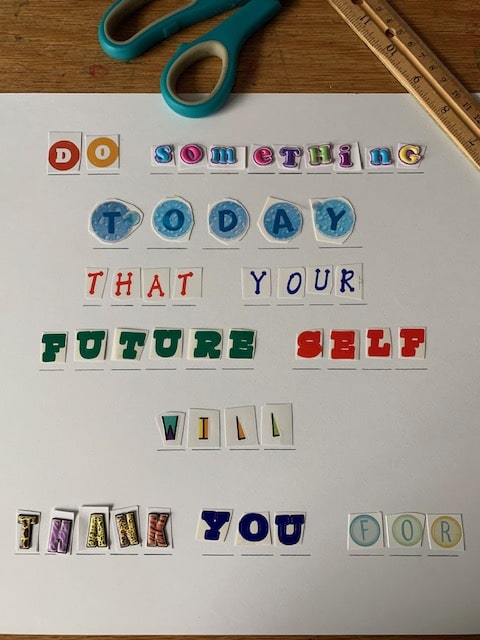
Supplies
- Letter stickers or printed letters in different fonts
- White paper for background
- Pencil
- Bag or box to hold letters
- Flat surface to hold paper
- Glue stick (if not using stickers)
Setup
First, choose a motivational quote and cut out letters with a variety of fonts and colors (you can also use letter stickers) to spell out the words.
For younger kids, make each word a different font or color. Older kids can be challenged by not making it obvious which letters go together to make an individual word.
Your kids will need to unscramble the letters to make each word, and then place the words in the right order to make the sentence.
In order to give them some guidance, provide a paper with lines underneath where each letter should be placed. This will allow them to see how many letters are in each word, and how many words are in the sentence.
Example: Do something today that your future self will thank you for.
(I chose to use letter stickers that made it easy for my kids to identify which letters should stay together to make a word. Each word in the sentence was assigned a different style of sticker.)
How to Play
Keep the paper that will hold the final sentence on a flat surface, like a table or desk, along with a glue stick if needed.
Give the letters to your kids one at a time, in random order, as they run back and forth to collect them.
They can pause to work on unscrambling a word at any time, but can receive only one letter each time they run back to you.
THROW-A-STATE CAPITALS GAME
Make reviewing state capitals a little bit more fun with this tossing game.
Supplies
- Roll of paper, poster board (or even a wall will do)
- Colorful index cards
- Sharpie
- Tape
- List of all 50 states and capitals
- Soft bouncy ball, ball of paper, paper airplane, nerf gun, or something else to throw at the game board
Setup
- Write the names of all 50 states on colorful index cards using Sharpie.
- Measure a roll of paper to approximately 30” x 40”. If using standard poster board, you’ll need 2 pieces.
- Tape each of the index cards onto the paper in random order, mixing up the colors.
- You should have 5 columns and 10 rows on your 30” x 40” paper, for a total of 50 states OR
- 5 columns by 5 rows on each of two poster boards, for a total of 50 states
- Use masking tape or painter’s tape to attach your game board to a hard surface like a wall or door.
How to Play
- Call out the name of a state capital from your printed list.
- Your child will answer the name of the state they think is correct, and throw their item at the game board, attempting to hit that state.
- Your kids take turns repeating through all 50 states.
- To award points: 1 point for correct answer, 1 point for hitting the state they aimed at.
- You can require them to redo states they answer incorrectly until they get it right, OR let them know they answered incorrectly and put that capital back in the rotation until one of them gets it right.
Switch this to print the capital names on the index cards and call out the names of the states if desired. If you award points, make sure to have fun prizes your kids can spend them on.
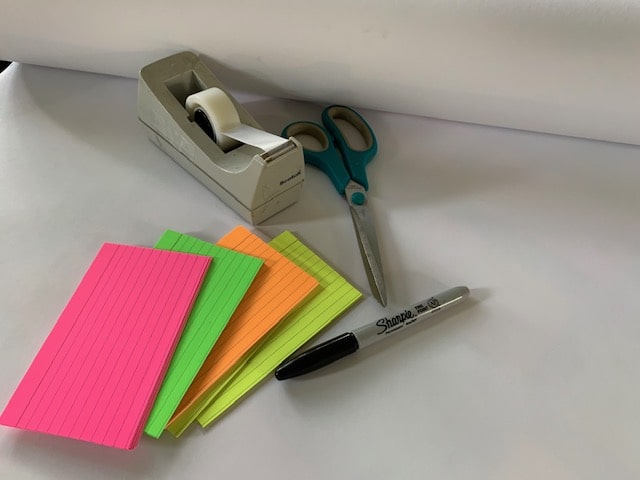
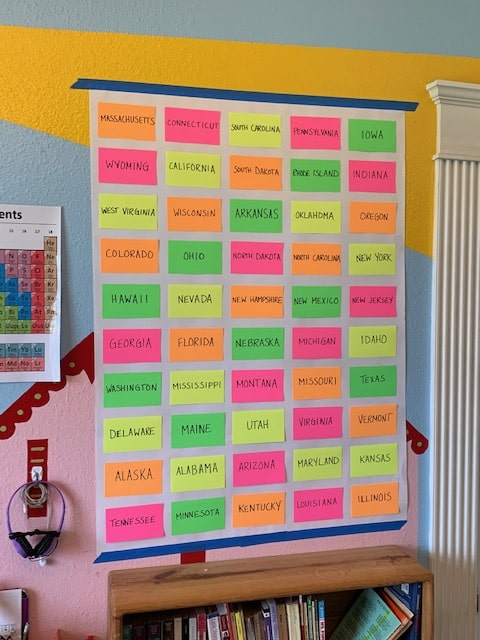
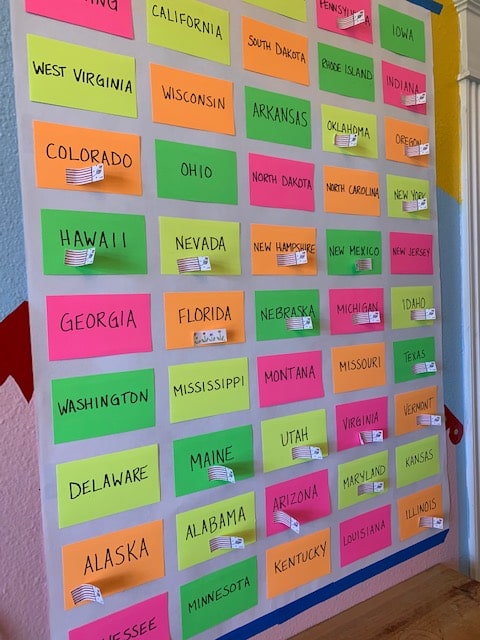
JUMP ROPE SPELLING BEE
Your kids have to jump and spell words at the same time!
Supplies
- Jump rope (your kids can take turns with one, or each have their own)
- List of grade-level appropriate spelling words (use individualized lists for each child if needed)
How to Play
- Call out a spelling word for your child.
- They should jump and say each letter in rhythm to spell out the word
- Award points for correctly spelling the word and/or keeping the jump rope going through the word
- Your kids take turns until you get to the end of the spelling list
- BONUS: speed round/double point
Don’t forget, if you’re awarding points, have some prizes your kids can earn!
CATCH THE ADJECTIVE ALPHABET GAME
Have your kids stand in a loose circle and use a ball they are able to catch (beach ball, foam ball, tennis ball). Have them toss the ball to one another and try to come up with an adjective for each letter of the alphabet.
The first person to catch the ball would start with “A,” the next person would give an adjective starting with “B,” and so on. If the person who catches the ball can’t come up with one, you can allow the other kids to help them, or they can add an adjective beginning with the letter that was just completed. So if a child catches the ball after someone says “icy,” but can’t come up with an adjective for “J,” they could say “icky.”
If you think your kids will struggle, have a list of adjectives across the room. When they are stuck and no one can come up with an adjective for the letter you’re on, have them run across the room and find an adjective that begins with that letter. They then run back to their place and continue the game.
Items You May Use on Fitness Friday
SCAVENGER HUNT
A scavenger hunt will get your kids up and moving. Send them on a search for specific household objects.
I’ve got a free printable scavenger hunt you can download from my printables library. Sign up below to be added to my email list and you’ll have access to the scavenger hunt, along with 200+ pages of printables available in my printables library.
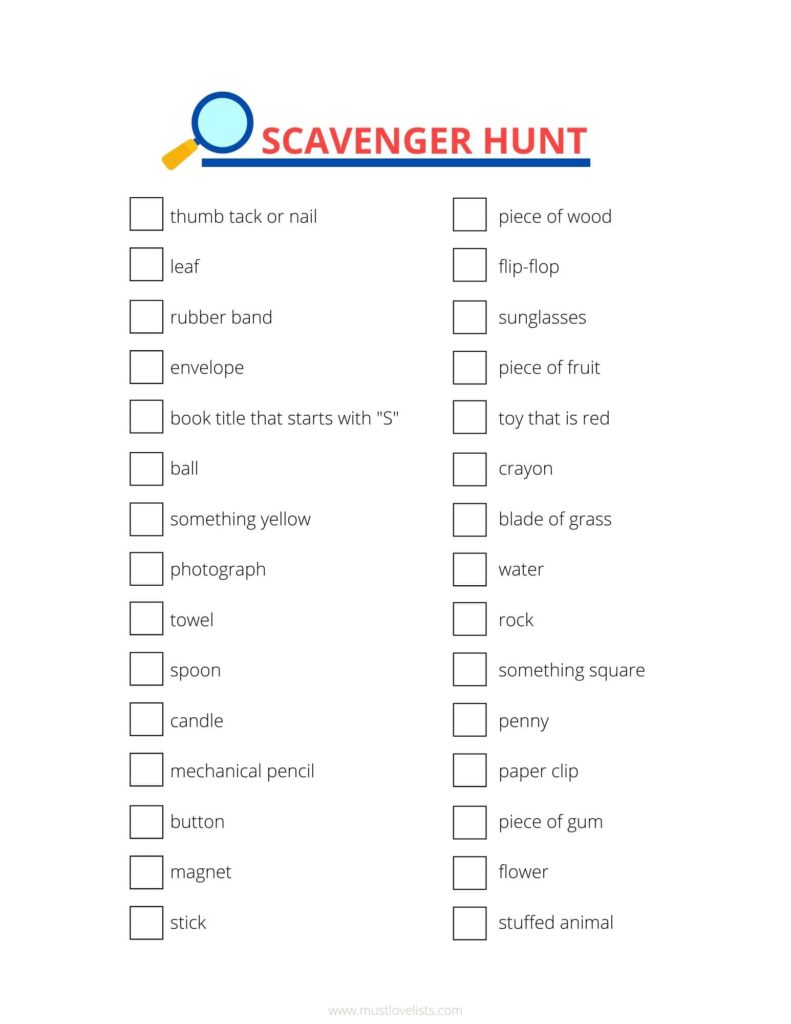
HOMESCHOOL FITNESS FRIDAY THEME DAY
9:00 AM: MORNING STRETCHES
9:15 AM: CREATE-A-QUOTE WORD SCRAMBLE
9:45 AM: THROW-A-STATE CAPITALS GAME
10:30 AM: SNACK
10:45 AM: MAKE A HEALTHY SNACK LIST
11:00 AM: GO FOR A WALK
11:30 AM: SCAVENGER HUNT
12:00 PM: LUNCH
12:30 PM: CATCH THE ADJECTIVE ALPHABET GAME
12:45 PM: OBSTACLE COURSE
2:00 PM: DONE FOR THE DAY!

THEMED DAYS FOR HOMESCHOOL FUN
That’s five days of themed activities you can use for an entire week of homeschool fun! Maker Monday, Tasty Tuesday, Wordy Wednesday, Theatrical Thursday, and Fitness Friday. Use these themes in whatever way works for your family. Try a monthly Maker Monday if your kids love making and creating. Or combine them all and plan a full week of themed fun to freshen things up in March or April when your kids are feeling unmotivated.
However you use theme days in your homeschool, your kids are sure to be enthusiastic about a little change of pace and a lot of learning fun!
Visit my homeschool resources page for monthly unit study ideas, projects, and homeschool planning help!

Join my mailing list to receive updates when new printable resources are added to the library, plus tips and encouragement for your organized homeschool journey.

